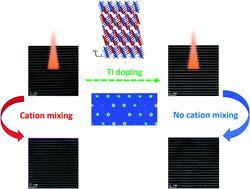Utilization of electron-beam irradiation under atomic-scale chemical mapping for evaluating the cycling performance of lithium transition metal oxide cathodes†
Abstract
With the development of high-performance lithium ion batteries, scanning transmission electron microscopy (STEM) combined with energy dispersive X-ray spectroscopy (EDX) has been widely applied as a high-precision technique to investigate the atomic-level features of doped lithium transition metal oxide cathodes. However, the corresponding effect of the high-energy electron beam irradiation during STEM has been largely ignored, even though it often causes structural modification or breakage of the ionic bonds in the material, leading to the misinterpretation of the atomic structure. Therefore, to improve the accuracy of atomic-level observation, it is important to develop a consolidated methodology that can specify the critical parameters that trigger the effect of the high-energy electron beam. To achieve this, the electron beam-induced radiolysis phenomena of layer-structured lithium mixed-transition metal oxides (LiNi0.6Co0.2Mn0.2O2, NCM) were characterized by STEM-EDX at different accelerating voltages. The results revealed that the susceptibility of the materials to electron beam irradiation significantly depends on the energy of the accelerated electrons; a 200 kV electron beam triggered cation migration that resulted in structural changes, while the original structure was retained for a prolonged duration under an 80 kV electron beam, thus securing the true structural information of the material. Remarkably, a small amount of Ti doping into NCM significantly increased its tolerance to the electron beam. Density functional theory calculations indicated that the high resistance of the Ti-doped NCM to the electron beam can be attributed to enhanced conductivity due to the semiconductor–metal transition. Furthermore, there was a reliable correlation between the observed phenomenon and the cycling performance of the materials, thus suggesting that STEM probe-based monitoring at atomic resolution can be exploited as an indicator of battery stability and life.



 Please wait while we load your content...
Please wait while we load your content...